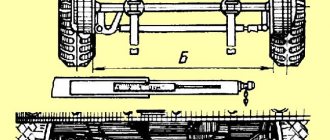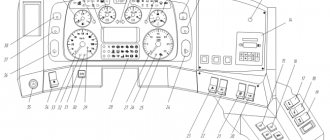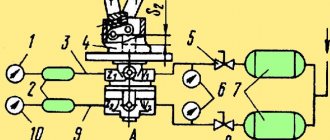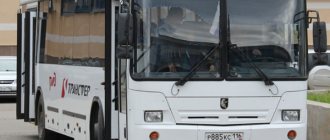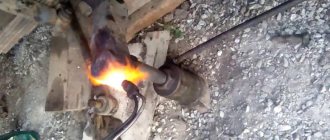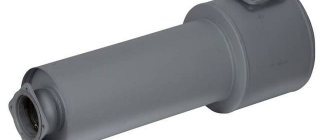The vehicle may be driven on paved roads and compacted dirt roads only with a rated tire pressure corresponding to the maximum load on the tire. On difficult sections of the route (wetlands, virgin snow, loose sand), a short-term decrease in the internal air pressure in the tires is allowed, while the maximum speed and mileage must correspond to the standards indicated in the table.
| Types of roads | Tire pressure, kPa (kgf/cm2; bar) | max speed, km/h | max mileage during the warranty period, km |
| wetland | 78,4 (0,8; 0,784) | 15 | 600 |
| Virgin snow | 108 (1,1; 1,08) | 25 | 800 |
| quick sand | 196 (2,0; 1,96) | 30 | 1400 |
| Roads of all types, only for the period of inflation of tires after difficult sections | 196 (2.0; 1.96) to nominal | 40 | 1400 |
The system is controlled from the driver's cabin. The tire pressure regulation system includes: air lock valves, pneumatic lines, air supply seal units, heads with air supply cuffs and controls for the tire pressure regulation system.
The air supply seal units are installed directly into the axle axles and ensure the tightness of the moving joint. Air enters the components through the fitting. From the cavity of the assembly, air flows through the axle shaft channel to the air shut-off valve and then through the connecting hose into the wheel tire.
Air shut-off valves are installed on each wheel; they are designed to disconnect the tires from the vehicle's pneumatic system.
Attention! To reduce wear on the sealing collar, it is recommended to close the wheel valves while driving. Open only to inflate tires.
On the vehicle it is possible to install an air shut-off valve in the following version:
- Option I - see fig. Air shut-off valve;
- Option II - see fig. Air shut-off valve (optional).
Air shut-off valve 1 – valve plug; 2 – valve body
Air shut-off valve (option) 1 – valve-axlebox clamp; 2 – locking flag
Operating order of the valve (see Fig. Air shut-off valve (option)):
- pull out the crane-axlebox lock 1 in direction B;
- by rotating the lock flag 2 until it stops, set the lock to the “Open” or “Closed” position;
- push the crane-axlebox lock 1 into its original position.
The controls for the tire pressure regulation system are located on the instrument panel: the distributor switch, the reduced pressure regulator and the nominal pressure regulator (see Fig. Control of the tire pressure regulation system).
Control of the tire pressure regulation system 1 - distributor switch; 2 – reduced pressure regulator; 3 - nominal pressure regulator
The regulators are adjusted to the minimum and nominal pressure in the pneumatic system (see table Minimum and nominal tire pressure).
Tire pressure*
| Tire size | Tire model | Vehicle model | Nominal pressure, kPa (kgf/cm2; bar) |
| 425/85 R21, 146J | KAMA-1260, KAMA-1260-1 | 5350 | 441 (4,5±0,24; 4,41) |
| 425/85 R21, 156G | KAMA-1260, KAMA-1260-1 | 43118, 43502, 53504 | 549 (5,6±0,2; 5,49) |
| 425/85 R21, 146K | O-184 | 5350 | 441 (4,5±0,2; 4,41) |
| 425/85 R21, 156J | O-184 | 43118 43502, 53504 | 549 (5,6±0,2; 5,49) |
| 395/80 R20 | KAMA-430 | 43501 | 441 (4,5±0,2; 4,41) |
| 390/95R20, 156J | KAMA-URAL | 43118 53504 43502 | 549 (5,6±0,2; 5,49) |
*Minimum pressure 80 kPa; 0.8±0.2 kgf/cm2; 0.8 bar
The distributor switch sets the tire pressure.
To reduce the air pressure in the tires, move the distributor switch to the left. In this case, the system will automatically set the tire pressure to which the low pressure regulator was previously adjusted. It is possible to set the tire pressure to any arbitrary value between the minimum and nominal. To do this, you need to set the tire pressure distributor switch to the left position and rotate the handle of the reduced pressure regulator to set the required pressure. To reduce the time for setting the nominal and reduced pressure, it is allowed to move the handle of the corresponding regulator to adjust the reduced or increased pressure by half a turn. The air pressure in the tires is determined by a pressure gauge with the wheel valves fully open. Do not allow tire pressure to differ from the nominal pressure. Monitor the tire pressure using a pressure gauge, ensuring that it does not differ from the recommended one. After setting the pressure, return the regulators to their original position.
To increase the air pressure in the tires, move the distributor switch to the right. In this case, the system will automatically set the tire pressure to which the nominal pressure regulator was previously adjusted.
What pressure should be in Kamaz tires?
Tire pressure with centralized regulation system
| Kamaz car 43118, 43502, 53504 | ||
| Tube tire size | 425/85R21 | 390/95R20 |
| Tire model | KAMA-1260, 156 G KAMA-1260-1, 156 G O-184, 156J | KAMA-URAL, 156J |
| Tire pressure of a vehicle of technically permissible maximum weight | 549 kPa 5.6±0.2 kgf/cm2 5.49 bar | |
Not available:
| № | Part code | Name | Part Information |
| 43118-3125001-40 | Installing a tire inflation system | Model 43118 Group Wheels and hubs Subgroup Tire inflation system piping Serial part number 001 Additionally Not interchangeable with a part previously released under the same number | Not available |
| 43118-3125015 | Installation of the solenoid valve | Quantity for KamAZ 43118 1 Model 43118 Group Wheels and hubs Subgroup Tire inflation system pipelines Part number 015 | Not available |
| 4310-3122001 | Control valve installation | Quantity for KamAZ 43118 1 Model 4310 Group Wheels and hubs Subgroup Pressure control valve for tire inflation system Part number 001 | Not available |
| 4310-3125050-20 | Flexible hose | Quantity for KamAZ 43118 6 Model 4310 Group Wheels and hubs Subgroup Tire inflation system pipelines Serial number of part 050 Additionally Not interchangeable with parts previously released under the same number | Not available |
| 4310-3125070-10 | A tube | Quantity for KamAZ 43118 1 Model 4310 Group Wheels and hubs Subgroup Tire inflation system pipelines Serial number of part 070 Additionally Not interchangeable with parts previously released under the same number | Not available |
| 4310-3125072-10 | A tube | Quantity for KamAZ 43118 1 Model 4310 Group Wheels and hubs Subgroup Tire inflation system pipelines Serial number of part 072 Additionally Not interchangeable with parts previously released under the same number | Not available |
| 4310-3125074 | Tube from control valve to wheel tires first assembled | Quantity for KamAZ 43118 1 Model 4310 Group Wheels and hubs Subgroup Tire inflation system pipelines Part number 074 | Not available |
| 43118-3125076-20 | A tube | Quantity for KamAZ 43118 1 Model 43118 Group Wheels and hubs Subgroup Tire inflation system pipelines Serial number of part 076 Additionally Not interchangeable with parts previously released under the same number | Not available |
| 4310-3125078-10 | A tube | Quantity for KamAZ 43118 1 Model 4310 Group Wheels and hubs Subgroup Tire inflation system pipelines Serial number of part 078 Additionally Not interchangeable with parts previously released under the same number | Not available |
| 43118-3125080-20 | A tube | Quantity for KamAZ 43118 2 Model 43118 Group Wheels and hubs Subgroup Tire inflation system pipelines Serial number of part 080 Additionally Not interchangeable with parts previously released under the same number | Not available |
| 43118-3125082-30 | A tube | Quantity for KamAZ 43118 1 Model 43118 Group Wheels and hubs Subgroup Tire inflation system pipelines Serial number of part 082 Additionally Not interchangeable with parts previously released under the same number | Not available |
| 43118-3125084-20 | A tube | Quantity for KamAZ 43118 1 Model 43118 Group Wheels and hubs Subgroup Tire inflation system pipelines Serial number of part 084 Additionally Not interchangeable with parts previously released under the same number | Not available |
| 43114-3125086 | A tube | Quantity for KamAZ 43118 1 Model 43114 Group Wheels and hubs Subgroup Tire inflation system pipelines Part number 086 | Not available |
| 43118-3125090-20 | A tube | Quantity for KamAZ 43118 1 Model 43118 Group Wheels and hubs Subgroup Tire inflation system pipelines Serial part number 090 Additionally Not interchangeable with parts previously released under the same number | Not available |
| 43118-3125092-20 | A tube | Quantity for KamAZ 43118 1 Model 43118 Group Wheels and hubs Subgroup Tire inflation system pipelines Serial number of part 092 Additionally Not interchangeable with parts previously released under the same number | Not available |
| 4310-3125094-10 | A tube | Quantity for KamAZ 43118 1 Model 4310 Group Wheels and hubs Subgroup Tire inflation system pipelines Serial number of part 094 Additionally Not interchangeable with parts released earlier under the same number | Not available |
| 4310-3125096-10 | A tube | Quantity for KamAZ 43118 1 Model 4310 Group Wheels and hubs Subgroup Tire inflation system pipelines Serial number of part 096 Additionally Not interchangeable with parts previously released under the same number | Not available |
| 4310-3125104-10 | A tube | Quantity for KamAZ 43118 1 Model 4310 Group Wheels and hubs Subgroup Tire inflation system pipelines Serial number of part 104 Additionally Not interchangeable with parts previously released under the same number | Not available |
| 43114-3125106 | A tube | Quantity for KamAZ 43118 1 Model 43114 Group Wheels and hubs Subgroup Tire inflation system pipelines Part number 106 | Not available |
| 43118-3125108-20 | A tube | Quantity for KamAZ 43118 1 Model 43118 Group Wheels and hubs Subgroup Tire inflation system pipelines Serial number of part 108 Additionally Not interchangeable with parts previously released under the same number | Not available |
| 43118-3125110-20 | A tube | Quantity for KamAZ 43118 1 Model 43118 Group Wheels and hubs Subgroup Tire inflation system pipelines Serial number of part 110 Additionally Not interchangeable with parts previously released under the same number | Not available |
| 43114-3125112 | A tube | Quantity for KamAZ 43118 1 Model 43114 Group Wheels and hubs Subgroup Tire inflation system pipelines Part number 112 | Not available |
| 43114-3125114 | A tube | Quantity for KamAZ 43118 1 Model 43114 Group Wheels and hubs Subgroup Tire inflation system pipelines Part number 114 | Not available |
| 43118-3125116-20 | A tube | Quantity for KamAZ 43118 1 Model 43118 Group Wheels and hubs Subgroup Tire inflation system pipelines Serial number of part 116 Additionally Not interchangeable with parts previously released under the same number | Not available |
| 4310-3125194-10 | A tube | Quantity for KamAZ 43118 1 Model 4310 Group Wheels and hubs Subgroup Tire inflation system pipelines Serial number of part 194 Additionally Not interchangeable with parts previously released under the same number | Not available |
| 43118-3125196 | A tube | Quantity for KamAZ 43118 1 Model 43118 Group Wheels and hubs Subgroup Tire inflation system pipelines Part number 196 | Not available |
| 43118-3125198 | A tube | Quantity for KamAZ 43118 1 Model 43118 Group Wheels and hubs Subgroup Tire inflation system pipelines Part number 198 | Not available |
| 43118-3125068 | bracket | Quantity for KamAZ 43118 1 Model 43118 Group Wheels and hubs Subgroup Tire inflation system pipelines Part number 068 | Not available |
| 4310-3125069-10 | bracket | Quantity for KamAZ 43118 1 Model 4310 Group Wheels and hubs Subgroup Tire inflation system pipelines Serial number of part 069 Additionally Not interchangeable with parts previously released under the same number | Not available |
| 4310-3125256 | bracket | Quantity for KamAZ 43118 2 Model 4310 Group Wheels and hubs Subgroup Tire inflation system pipelines Part number 256 | Not available |
| 43118-3125270-20 | bracket | Quantity for KamAZ 43118 2 Model 43118 Group Wheels and hubs Subgroup Tire inflation system pipelines Serial number of the part 270 Additionally Not interchangeable with a part previously released under the same number | Not available |
| 4310-3723228 | Sealing gasket | Quantity for KamAZ 43118 4 Model 4310 Group Electrical equipment Subgroup Electrical wire connectors Part number 228 | Not available |
| 5320-3703301 | Bushing through passage | Quantity for KamAZ 43118 2 Model 5320 Group Electrical equipment Subgroup Rechargeable battery Part serial number 301 | Not available |
| 55102-2411052 | Fitting bracket | Quantity for KamAZ 43118 1 Model 55102 Group Rear axle Subgroup 2411 Part number 052 | Not available |
| 864850 | Tee | Quantity for KamAZ 43118 1 Coating without coating | Not available |
| 853938 | Bracket | Quantity for KamAZ 43118 6 Coating without coating | Not available |
| 864880 | Flange fitting | Quantity for KamAZ 43118 4 Coating without coating | Not available |
| 864882 | Square | Quantity for KamAZ 43118 2 Coating without coating | Not available |
| 1/09024/21 | Bolt M6-6gх20 | Quantity for KamAZ 43118 2 Fastener yes Material steel 80 (steel with tensile strength 784-980 (80-100) MPa (kg/mm2) Coating galvanized | Not available |
| 1/60436/22 | Bolt M8-6gx25 tab. VAZ 10312 | Quantity for KamAZ 43118 6 Fastening part yes Material steel 80 (steel with tensile strength 784-980 (80-100) MPa (kg/mm2) Coating chrome plating | Not available |
| 1/59705/21 | Bolt M10x1.25-6gx20 | Quantity for KamAZ 43118 3 Fastening part yes Material steel 80 (steel with tensile strength 784-980 (80-100) MPa (kg/mm2) Coating galvanized | Not available |
| 1/61008/11 | Nut M8x1.25-6N | Quantity for KamAZ 43118 6 Fastening part yes Material steel 50 (steel with tensile strength 490-784 (50-80) MPa (kg/mm2) Coating galvanized | Not available |
| 1/07910/11 | Nut M10x1.25-6N | Quantity for KamAZ 43118 9 Fastening part yes Material steel 50 (steel with tensile strength 490-784 (50-80) MPa (kg/mm2) Coating galvanized | Not available |
| 1/02906/90 | Clamp for fastening couplings assembled | Quantity for KamAZ 43118 4 Fastening part yes Material mixed materials (assembly) Coating uncoated | Not available |
| 1/05164/77 | Spring washer 6 | Quantity for KamAZ 43118 2 Fastener yes Material other metal materials, i.e. not steel, not brass, not light alloy, not copper Coating special coating | Not available |
| 1/05168/77 | Spring washer 10 | Quantity for KamAZ 43118 3 Fastening part yes Material other metal materials, i.e. not steel, not brass, not light alloy, not copper Coating special coating | Not available |
| 1/09024/31 | Flat washer 18x32 tab. VAZ 10172 | Quantity for KamAZ 43118 1 Fastener yes Material steel 100 (steel with tensile strength 980-1176 (100-120) MPa (kg/mm2) Coating galvanized | Not available |
Test drive KAMAZ 43118
First, we test the truck on a route simulating city traffic. Here the car shows good results both in terms of dynamics and fuel consumption, which amounted to 32.5 liters per hundred when driving at an average speed of 38.6 km/h. The figure for a heavy all-wheel drive truck is quite decent.
Having made several laps along the route on our own and with a test driver, we come to the conclusion that the gear shift drive is insufficiently reliable. On each lap of the route, which was 18 km, three to five errors regularly occurred when changing gears.
Most likely, the problem arose due to the selection being too small. The optimal shifting algorithm when driving a car without a load in top gear turned out to be 2-4-6-7.
Next, the truck was tested on a dynamometer road. Having warmed up the engine sufficiently, we accelerate it to maximum speed, and with surprise we determine the speed is 125 km/h, which is very good for an all-wheel drive truck of this class. We were also pleasantly surprised by the fuel consumption figures, which amounted to 18.4 liters at a speed of 50 km/h and 27.8 when driving at a speed of 80 km/h.
The next step was the primer. Driving over bumps and potholes on such a suspension is a dubious pleasure. The dirt test section is replete with all sorts of descents and steep climbs, and we did not expect to ride along it in the test KamAZ in comfort; speed capabilities on the ground were not tested at all, since here the only task was to simply stay in place and continue working with the equipment.
However, there are no critical remarks about the car here; we can only point out that the shaking is too strong when driving through sections of the road with uneven surfaces.
Testing a loaded vehicle
The empty vehicle testing is completed and the vehicle is loaded with ballast to continue testing. Now, with an already loaded car, we repeat the races along all routes. On a track simulating a city road, a loaded vehicle weighing more than 21 tons demonstrates good dynamics. Eight main gears and one reduction gear fully satisfy the needs of the engine.
Engine KAMAZ 740.30-260
In the loaded version, the optimal switching algorithm when the car is moving in top gear turned out to be 1-3-5-6-7. However, when driving under a load, fuel consumption indicators increased significantly.
Last but not least, an increase in rolling resistance of loaded tires could contribute to the decrease in fuel efficiency. The speed decreased by only 1.3 km/h.
A similar picture of fuel consumption was present when passing a section of the dynamometer road. The loaded car, in the maximum speed test, managed to accelerate to 102.8 km/h.
When driving under a load, sometimes you get the feeling that the engine is slightly lacking in power, although its values are quite consistent with the parameters of the car.
Updated KAMAZ 43118 truck
There are hardly people in our country who are unfamiliar with the products manufactured by KamAZ OJSC.
And this is not surprising - after all, the Kama Automobile Plant is the world's largest enterprise producing trucks. True, for various reasons, today KamAZ does not use its full production potential, but the plant is constantly working on the development and implementation of new technologies and improving product quality. The testing department of our editorial team had the honor of conducting a test drive of one of the most interesting truck models produced at the plant - the KamAZ 43118 flatbed truck in its updated version.
KAMAZ errors via OBDII protocol
Fuel system and air supply
P0000-P0099, P0100-P0199, P0200-P0299
P008A - Low Fuel Pressure Circuit Low Pressure
P008B - Low Fuel Pressure Circuit High Pressure
P0102 - Low signal level from the mass air flow sensor
P0103 - High signal level from the mass air flow sensor
P0105 / 0105 - Malfunction in the electrical circuit of the intake absolute pressure sensor / atmospheric pressure sensor
P0107 - Low signal level from the boost air pressure sensor
P0108 - High signal level from the boost air pressure sensor
P0110 / 0110 - Malfunction in the electrical circuit of the intake air temperature sensor
P0112 - Low signal level from charge air temperature sensor
P0113 - High signal level from the charge air temperature sensor
P0115 / 0115 - Malfunction in the electrical circuit of the coolant temperature sensor
P0116 / 0116 - Incorrect functioning of the coolant temperature sensor
P0117 - Low signal level from the coolant temperature sensor
P0118 - High signal level from the coolant temperature sensor
P0121 - Incorrect signal from pedal position sensor (1 track)
P0127 - Exceeding the emergency charge air temperature
P0168 - Fuel overheating
P0180 / 0180 - Malfunction in the electrical circuit of the fuel temperature sensor
P0193/0193 – Fuel Rail Pressure Sensor Input High
P0195 / 0195 - Malfunction in the electrical circuit of the engine oil temperature sensor
P0201 - Broken injector 1 cylinder
P0202 - Broken injector 2 cylinders
P0203 - Broken injector 3 cylinder
P0204 - Broken injector 4 cylinder
P0217 - Engine temperature above alarm limit
P0219 - Engine speed above the maximum permissible
P0221 - Incorrect signal from pedal position sensor (track 2)
P0261 - Injector 1 cylinder short to ground
P0262 - Short to power injector 1 cylinder
P0264 - Injector 2 cylinder short to ground
P0265 - Short to power injector 2 cylinder
P0267 - Injector 3 cylinder short to ground
P0268 - Short to power injector 3 cylinder
P0270 - Injector 4 cylinder short to ground
P0271 - Short to power injector 4 cylinder
Ignition system
P0335 - Open position sensor HF
P0336 - HF Position Sensor Synchronization Error
P0337 - Low signal level of the crankshaft position sensor DPKV
P0340 - Camshaft position sensor signal interruption
P0341 - Camshaft Position Sensor Range Error
P0342 - Low signal level of the camshaft position sensor DPRV
Emission control
P0403 - EGR valve circuit open
P0420 - Exhaust Converter Low Efficiency
Speed and idle control
P0500/0500 - Speed sensor circuit malfunction
P0501 - Vehicle speed sensor malfunction
P0562 - Low on-board voltage
P0563 - High on-board voltage
Electronic control unit (ECU) and its subsystems
P0603 - Control unit EEPROM error
P0606 - Control unit error
P0610 - Control unit reset error
P0645 - Air conditioner relay primary circuit open
P0646 - A/C relay primary circuit short to ground
P0647 - A/C relay primary circuit short to power
P0650 - Malfunction in the electrical circuit of the malfunction indicator lamp
Transmission
P0700-P0799, P0800-P0899, P0900-P0999
Properly inflated tires save money
Any vehicle driving on flat tires causes unnecessary financial expenses, and Kamaz especially. Low pressure will bring a lot of problems, regardless of the model and application:
- Kamaz 4308. A city truck with a small wheelbase and carrying capacity. Number of stingrays - 6.
- Kamaz 4310. The so-called “timber truck”. Suitable for traveling over rough terrain, off-road, and dirt roads.
- Kamaz 43118. A universal vehicle that is used as dump trucks, tractors, and flatbed trucks.
- Kamaz 5320. In most cases, it is an on-board vehicle adapted for movement on asphalt.
- Kamaz 65115. A draft horse designed for work in the industrial sector (construction, mining, metallurgy, etc.)
Naturally, the pressure in the wheels of KamAZ 65115 is higher than that of KamAZ 4308. In any case, if you do not maintain it within normal limits, the consequences will be:
- decreased controllability;
- premature wear and failure of chassis and gearbox parts;
- increase in braking distance;
- risk of disassembling the wheel while driving;
- excessive fuel consumption.
Overpressure in Kamaz tires will also not bring anything good:
- The central part of the tread will quickly wear off.
- Increased pressure in the tires of a Kamaz vehicle is the cause of skids and accidents.
- Vibration destroys the body, frame and all mechanical components and fastenings.
- The risk of puncture increases.
- The tire may explode.
It doesn’t matter what the pressure is, but if it doesn’t meet the standard, the risk of harming road users and your wallet increases significantly.
bad blood pressure | Topic started by: Miyuki
Salute to all KAMAZ drivers! The following problem appeared: on the KamAZ it became difficult to pump air into the system, up to 5.5 at idle it pumps normally, and above that it is already difficult and very slow.
Andrey (Coronis) look at the cut-off valve. Although most likely the compressor is “ales kaput”
Olexiy (Fasih) Possibly different, this happened to me because of the valves (in the compressor)
Evgeny (Quon) definitely for the compressor
Alexander (Yoshio) look at all the tubes, maybe there’s a break, I had it like that until 5, it shakes and that’s it, I’ve been looking for where the hiss is for a long time
Mister (Tallulah) is not a pipe, It’s a valve, or rather a discharge valve, It’s being bent by the bastard
Anatoly (Gaetano) guys, I have a problem, help, it pumps air only at high speeds and ate, ate, two presses of the brake pedal, and the whole car releases the brakes! what to do??
Niaz (Sudhi) what is the cost of the compressor?
Arthur (Wambua) I came across this. I installed 3 new compressors and no show off. there was a reason for everything in the Russian Far East
Seryoga (Lilia) please tell me yesterday I started constantly relieving the pressure of the soldier EVEN WITH 2 GLASSES IT WORKS. today I did it directly, the compressor barely pumped up 6, what could it be
Evgeny (Quon) The condensate in the tubes is frozen, most likely, if the copper tubes take a blowtorch in your hands and go and warm them up! And pour dehumidifier into the alcoholic, everything should be fine! )
Kamil (Alexandrina) The new Kamaz pumps up to 5'5. I changed the compressor, changed the hose pump, changed the triple counting valve. It doesn't pump. One of the receivers is humming.
Ruslan (Andongwisye) Salute to all drivers! Such a problem, it pumps air up to 6 atmospheres, then, well, not like, before and after the soldier it pumps the same way, maybe someone can tell me. Thank you in advance!
Andriy (Shayla) Guys help solve this problem on KAMAZ, the lower scale pumps air 8 and the upper one 4, so in just over an hour you can pump nothing.
Ilfat (Pravin) Could the compressor pump poorly due to the water separator filter? if it is clogged for example.
Sasha (Wehilani) Hello everyone. The problem is this: the compressor is working, I checked all the tubes, but the air is not pumping, what should I do?
Sasha (Wehilani) Hello everyone. The problem is this: the compressor is working, I checked all the tubes, but the air is not pumping, what should I do?
Dinar (Anoushig) Sasha, isn’t he pumping anymore?
Ranis (Shakambhari) Dinar, I have such a situation, I installed a new compressor, it pumps 1 point and drives oil! what's the matter? please tell me if you know!
Malfunctions of the service brake system
Ineffective braking of the car when you press the brake pedal occurs if the brake valve drive is out of alignment or the two-section brake valve is faulty. If, during braking, the pressure in the brake chambers is nominal, then the wheel brake mechanisms are misaligned or faulty.
If, when braking with the service brake, the pressure is below normal only in the brake chambers of the front axle, then either the lower section of the brake valve or the pressure limiter is faulty. If the pressure in the brake chambers is normal, but braking is not effective, then the stroke of the brake chamber rods is greater than normal, or, for example, the brake linings are oily.
When you press the brake pedal, the braking of the wheels of the rear cart is ineffective or does not occur at all (the front wheels brake normally). In the pneumatic part of the drive, the upper section of the brake valve or the brake force regulator may be faulty. In the mechanical part, the brake mechanisms or the drive of the brake force regulator lever are faulty or misaligned.
If, after releasing the brake pedal, all the wheels of the car do not release the brakes, then the two-section brake valve is faulty (the pusher or the upper piston is jammed). It is possible that the brake valve drive is out of adjustment (there is no free play of the brake pedal).
If air does not come out of the rear brake chambers after releasing the brake pedal, the brake force regulator or the upper section of the brake valve is faulty. These malfunctions lead to a delay in the release of air from the front brake chambers. If, when releasing the brakes, air is not released only from the front brake chambers, then the pressure limiter or the lower section of the brake valve is faulty.
How long to pump the wheels on a Kamaz
thanks for the video, good man, hello from Kazakhstan
On each wheel it is written how much the given wheel needs to be pumped. Look carefully.
Why doesn’t KamAZ pump more than 6 atmospheres per wheel??
7.2 all around, this is optimal for Kamaz, on original tires, but in general for the military, the pressure is written above the wheels, from the factory..
In Maz 320 12.00 I always pumped 9 atmospheres
I have 9 task, download 7 front 6.5
so I don’t understand, the pressure is 10.0 or 7.5-8 atm
for the especially gifted! On each tire, it is written how much it needs to be pumped by the manufacturer. not a car, but tires.
@Igor Grigoriev, in fact, only theorists tell how and where it is written by whom
for those especially gifted: on each tire the MAXIMUM permissible pressure for it is written (which is better not to exceed). and how much you need to download, you need to look at the factory recommendations for the car. For example, for passenger cars (yes, the same VAZ) the tire says “Max.Pressure: 3.4Bar”, but if you pump up 3.4 atmospheres, then when you drive, you can go crazy. but the instructions for the car say that you need to pump 2.0 atmospheres, which is the most acceptable pressure.
Buddy! I agree that you can’t put it unpaired! But not because one will explode or go bald! And because of the lower class, the protector on it will turn into trash over time! I went through this myself! However, I put the class 1 size smaller! I just needed to get there, sorry I’m writing from my phone!
Rocked nine on Chinese tires. The tires are excellent.. Why check. If the tires are normal. If you bet. Russian wheels. And you will. Bart. A wheel a day.. If overloaded. And Chinese tires. Disposable. Afraid of side cuts. But the tonnage can withstand. Soft. The cameras are thin. They only don’t stick to the textiles. That is. Punctured for miscarriage. Buy a new wheel with a camera. But the Chinese make better tires. How. Our. The Chinese are holding the road well. Kamaz on wedge rims is crap. Better discs with nuts...
I bought new wheels, blew 10k in there and I can’t even blow it with 6k in front. Kamaz 1 Oska I carry 6 pallets of bricks and paving stones and for me 6,7,8,9 atmospheres are not enough + the slightest puncture can be heard and when the wheel is bad in time it self-lectures and hurray repairs are not needed buy a new one
Please tell me, is it better without a camera or with a camera? I'm just a beginner and wanted to know
Tubeless is definitely better. by a lot
Are there winter tires for heavy trucks with Velcro studs like for a passenger car?
@Damir Extensive I haven’t heard of a studded one being produced, but there is definitely a winter one. And in Norway, they won’t let you in for all-season driving in winter. And for the winter, chains must also be kept in the car. (In Norway, Austria, etc.) I heard they want to pass such a law in Russia too.
on trucks all-season, there is no point in installing and generally producing studded tires
Necessary information. Important, practical advice! Thank you
